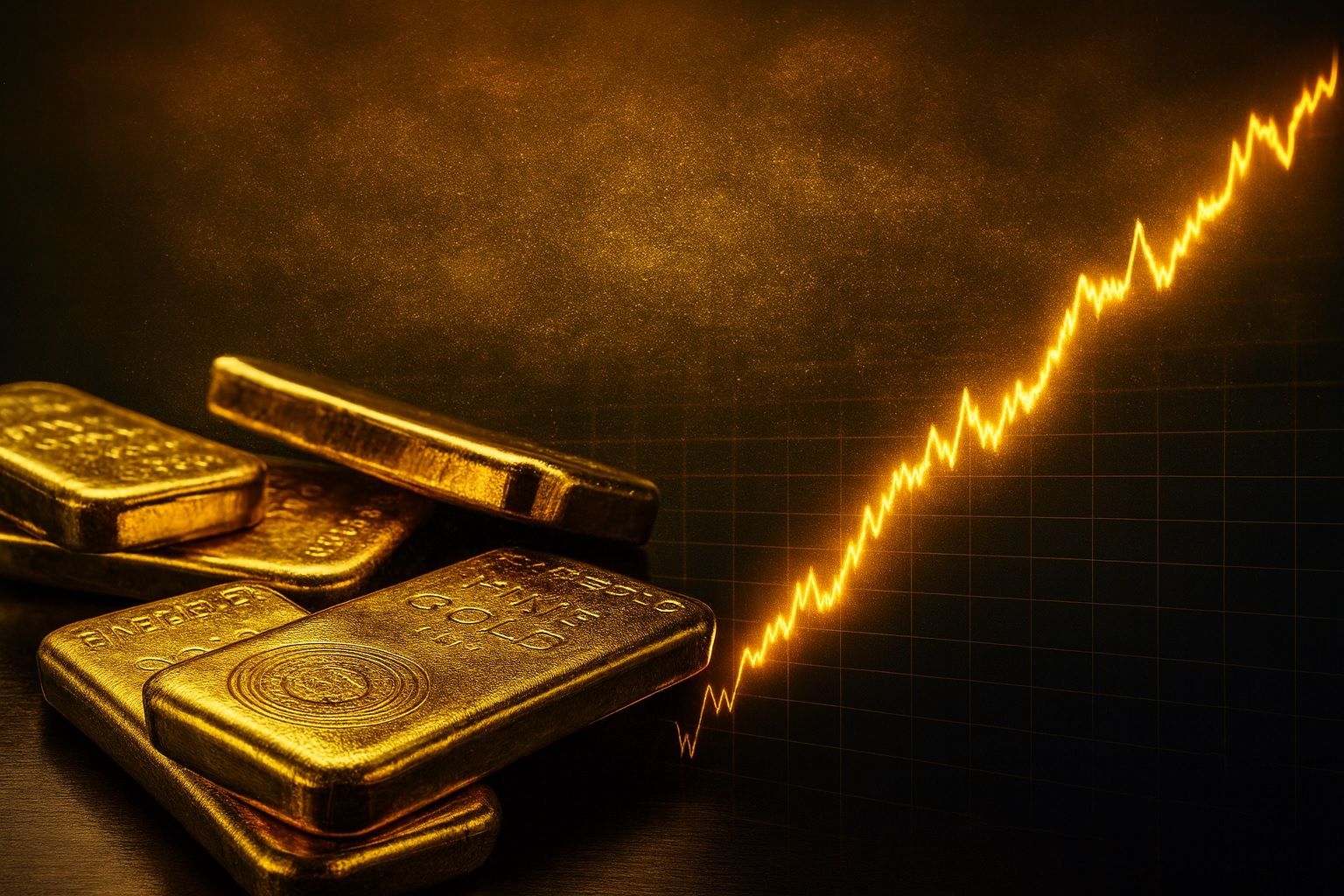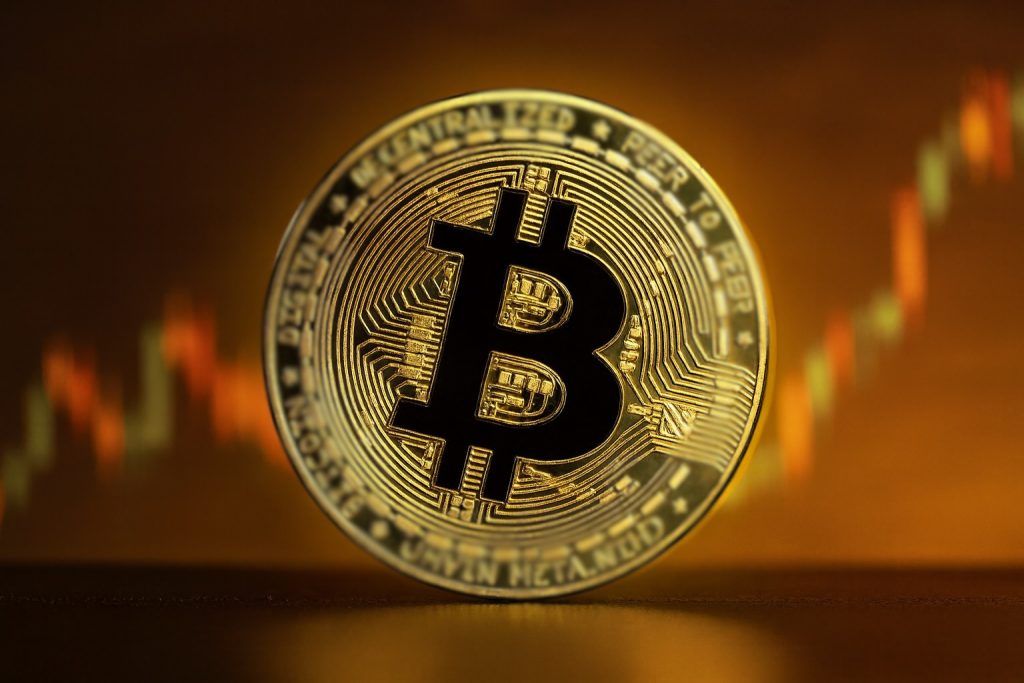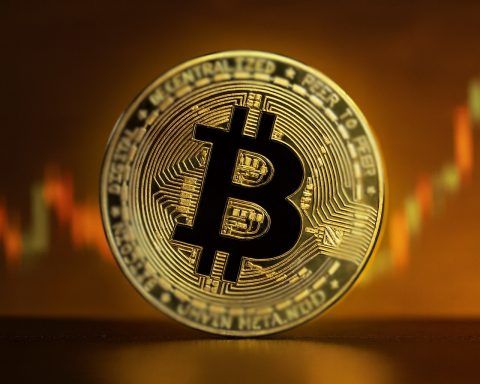Gold has sprinted through 2025, smashing record after record and forcing analysts to rewrite their forecasts in real time. With spot prices now hovering just above $4,000 per ounce and only weeks left in the year, the key question for investors is simple: does gold consolidate, correct, or break to fresh highs before 2026 arrives?
Below is a deep dive into where gold stands today, what’s driving the market, how major institutions see prices into year‑end, and the key scenarios for the rest of 2025.
Important: This article is for information and education only and is not investment or trading advice.
Gold price today: a historic year near its peak
As of 21 November 2025, spot gold closed around $4,078 per ounce, after touching a series of fresh records over the autumn. [1]
A few key stats capture how extreme this year has been:
- Record highs: Gold hit an all‑time high of about $4,381/oz on 20 October 2025. [2]
- Huge year‑to‑date gains: By late October, spot prices were up roughly 50% in 2025 according to World Gold Council (WGC) data reported by Reuters. [3]
- Relentless momentum: Gold was already up about 26% in the first half of 2025, setting 26 new all‑time highsby June, the best performance among major asset classes. [4]
World Bank forecasts suggest that 2025 will likely end with gold prices roughly 35–42% higher year‑on‑year, the strongest annual gain since the late 1970s. [5]
Put simply: gold is having one of its biggest years in modern history, and we’re entering the final stretch from a very elevated base.
Why gold exploded in 2025
Gold’s rally isn’t driven by a single headline—it’s the product of monetary policy, geopolitics, central banks, and investor psychology all pulling in the same direction.
1. Central bank buying & de‑dollarization
Central banks have been the quiet but powerful engine behind this bull market:
- In 2024, central banks bought over 1,000 tonnes of gold for the third year in a row, helping push total demand to a record 4,974 tonnes. [6]
- Their share of global demand has roughly doubled compared with the mid‑2010s, reaching close to a quarter of total demand. [7]
- The World Bank expects central bank purchases to remain elevated in 2025, supported by concerns about U.S. fiscal deficits, sanctions risk, and a weakening dollar. [8]
VanEck and other asset managers describe this as part of a “new era of structural strength” for gold, driven by reserve diversification away from the U.S. dollar—often called de‑dollarization. [9]
2. ETF and investment demand at record levels
If central banks are the foundation, investors and ETFs are the accelerant:
- In Q3 2025, global gold demand hit a quarterly record of 1,313 tonnes, up 3% year‑on‑year, as investment demand surged. [10]
- Total investment demand (bars, coins, ETFs) reached 537.2 tonnes in Q3, up 13% from Q2 and 47% from a year earlier. [11]
- Physically‑backed gold ETFs saw their strongest quarter since 2020, with September alone bringing about $26 billion in inflows and pushing global ETF assets above $470 billion. [12]
- In China, investors have piled into gold funds at a record pace; Chinese gold ETF holdings doubled their global share in early 2025 and made up more than half of global ETF inflows in some months. [13]
This mix of fear‑driven buying and FOMO buying has transformed gold into the year’s standout asset, outpacing both equities and bitcoin. [14]
3. Fed policy, real yields and the dollar
Gold thrives when real interest rates are low and the dollar is weak:
- The WGC’s mid‑year outlook notes that gold’s 26% H1 gain was heavily tied to a weaker U.S. dollar and expectations of Federal Reserve rate cuts, alongside persistent geopolitical risk. [15]
- World Bank projections assume continued U.S. monetary easing and see gold prices remaining far above their 2015–2019 average—by roughly 150%—through 2025–26. [16]
Lower or falling real yields reduce the opportunity cost of holding non‑yielding gold, while a softer dollar makes it cheaper in other currencies. That macro backdrop has been extremely supportive in 2025.
4. Geopolitics & tariffs: a persistent risk premium
From Middle East tensions to an unpredictable U.S.–China trade landscape under President Donald Trump’s administration, geopolitical risk has been a constant theme. [17]
The World Gold Council estimates that risk and uncertainty alone contributed a significant slice of gold’s 2025 returns, with trade‑related tariffs and conflicts amplifying demand for safe‑haven assets. [18]
5. Physical demand and supply dynamics
High prices have hit jewellery demand but boosted investment and recycling:
- Q3 2025 jewellery fabrication fell about 23% year‑on‑year, as high prices deterred price‑sensitive consumers. [19]
- At the same time, bar and coin demand rose 17%, led by India and China, and gold recycling increased 6%, while mine production grew 2%. [20]
In other words, the consumption side has softened, but investment and official‑sector demand have more than compensated, keeping the market tight.
What major institutions forecast for gold by end‑2025
Analysts have been racing to keep up with gold’s surge, and some of their earlier forecasts now look conservative compared with a spot price above $4,000. Still, looking at the major houses gives a sense of the range of expectations.
World Bank: a big year, cooler gains ahead
The World Bank’s October Commodity Markets Outlook projects: [21]
- ~42% rise in gold prices in 2025 versus 2024 (strongest since the late 1970s)
- More modest gains of around 5% in 2026 and 6% in 2027
This effectively frames 2025 as a “step‑change” year, with prices settling into a structurally higher range rather than reverting to pre‑2022 levels.
World Gold Council scenarios for H2 2025
In July, the WGC laid out three scenarios for the second half of 2025: [22]
- Consensus / baseline: Below‑trend global growth, elevated geopolitical risk, gradual Fed cuts
- Implied gold performance: rangebound with slight upside (roughly 0–5% higher in H2, or ~25–30% for 2025 as a whole)
- Bull case: Deteriorating conditions (stagflation or recession)
- Implied additional 10–15% rise in H2, potentially leaving gold almost 40% higher for the year
- Bear case: “Risk resolution” (improving growth and higher yields)
- Implied 12–17% H2 pullback, but still a positive year overall
They also flagged $3,000/oz as a key technical support level in a deeper correction scenario.
Investment banks: broadly bullish, but with wide dispersion
Forecasts from major banks span a wide range:
- Goldman Sachs
- J.P. Morgan Research
- Expects gold to average around $3,675/oz in Q4 2025, rising toward $4,000 by mid‑2026, underpinned by strong central bank and investor demand. [25]
- UBS
- In September, raised its end‑2025 target to $3,800/oz, and $3,900 by mid‑2026, pointing to Fed easing, dollar weakness and geopolitical risks as key drivers. [26]
- HSBC
- In October, lifted its 2025 average gold price forecast to $3,355/oz and 2026 to $3,950, citing safe‑haven demand, fiscal deficits and persistent central‑bank buying. [27]
- Morgan Stanley
- Earlier in the year, one widely‑cited forecast saw gold at $2,700 in Q4 2025, warning about demand destruction and more recycling if prices stayed high. [28]
- By late October, the bank acknowledged the strength of the move and said gold could reach $4,500/oz by mid‑2026, supported by strong ETF and central‑bank demand despite the recent correction from October’s high. [29]
- Standard Chartered, UBS, ANZ, BofA and others
- A survey of major banks and brokers compiled in late October shows targets in a broad band from roughly $3,250 to $5,000 per ounce by 2026, with Standard Chartered reportedly among the more bullish near‑term houses, eyeing $4,300 for 2025. [30]
- Retail & AI‑driven forecasts
- A BullionVault survey and AI models earlier in November projected gold at around $3,070/oz by end‑December 2025—forecasts which have already been overtaken by spot prices above $4,000. [31]
The takeaway: almost everyone was bullish, but few anticipated how quickly gold would leap above $4,000. As of late November, spot prices sit well above many published year‑end targets.
Scenario outlook for gold prices to 31 December 2025
With barely a month left, any forecast is more about mapping risks and ranges than pinning down a precise number. Combining current spot levels with institutional targets and the WGC/World Bank frameworks, three broad scenarios stand out.
These are not guarantees—they’re plausible paths based on current information.
1. Baseline: consolidation above $3,700, volatile around $4,000
Narrative
- The Fed sticks to a gradual easing path.
- The dollar stays soft but avoids a fresh collapse.
- Geopolitical tensions remain elevated but don’t spiral into a new major conflict.
- Central bank and ETF demand stay strong, but speculative froth eases.
Implications
- Prices likely trade in a wide band roughly between $3,700 and $4,300/oz into year‑end.
- This band roughly aligns with forecasts from UBS ($3,800), J.P. Morgan ($3,675 average), and more optimistic houses like Standard Chartered ($4,300), while acknowledging spot is currently near the upper end. [32]
- Volatility remains high: $100–$150 daily swings are entirely possible at these price levels.
In this scenario, gold essentially digests its 2025 gains rather than launching another vertical leg.
2. Bullish: fresh record highs, push toward $4,400–$4,800
Triggers
- Faster‑than‑expected Fed cuts or a sharper drop in real yields
- A new geopolitical shock or escalation of existing conflicts
- Signs of stagflation or a sharper global downturn
- Acceleration in central‑bank buying or another wave of FOMO ETF inflows
Implications
- The WGC’s “deteriorating conditions” bull case sees room for gold to rise another 10–15% in H2 from mid‑year levels, which would be consistent with a push toward or above the October record near $4,381, potentially into the $4,400–$4,800 zone before year‑end. [33]
- Some institutional and independent analysts already float upside scenarios toward $5,000 and even $5,600 by 2026, implying that a strong Q4 could front‑load part of that move. [34]
This is the “melt‑up” outcome, where gold briefly behaves more like a momentum tech stock than a defensive metal.
3. Bearish: a sharper correction back toward $3,300–$3,700
Triggers
- Hawkish surprises from the Fed or other major central banks
- A stronger‑than‑expected rebound in global growth and risk appetite
- A sharp rebound in the U.S. dollar
- Evidence that central bank or ETF demand is tapering off more quickly than expected
Implications
- The WGC’s bear case suggests a possible 12–17% H2 pullback, which would be consistent with dealers talking about $3,000 as a strong support zone. [35]
- Given current spot levels just above $4,000, a move back into the $3,300–$3,700 area by year‑end would fit a classic post‑blow‑off correction while still leaving 2025 as an outstanding year in percentage terms.
- Early‑year forecasts like Morgan Stanley’s $2,700 Q4 target illustrate that some strategists still see room for deeper downside if demand weakens and recycling grows. [36]
Even in this bearish scenario, gold would likely finish 2025 well above its pre‑2024 trading ranges, preserving much of its structural re‑rating.
Key risks that could shift the 2025 outlook
Downside risks
- More aggressive central banks: If inflation proves sticky and policymakers deliver fewer cuts—or even hint at hikes—real yields could rise and pressure gold. [37]
- Sharp USD rebound: A sudden rush back into dollar assets—for example, after a major trade or diplomatic breakthrough—would typically weigh on gold. [38]
- Demand fatigue: At high prices, jewellery demand is already under pressure; if ETF inflows slow and central banks reduce purchases more than expected, headline demand could soften quickly. [39]
Upside risks
- New geopolitical shocks: Further escalation in existing conflicts or fresh crises could recreate the kind of “fear premium” seen earlier in 2025. [40]
- Worse‑than‑expected growth: A global slowdown or recession would likely support more aggressive easing and safe‑haven flows into gold. [41]
- Accelerated de‑dollarization: If more countries visibly diversify reserves away from the dollar toward gold, official‑sector buying could surprise to the upside again. [42]
What this means for investors
From a portfolio perspective, the 2025 rally has two big implications:
- Gold is already “proven” as a hedge in this cycle.
It has outperformed major asset classes since 2024 and responded strongly to geopolitical and monetary shocks. [43] - Valuations are stretched, and volatility is elevated.
Banks like HSBC, J.P. Morgan and UBS set targets in the $3,100–$3,800 range, yet prices are already above $4,000. That doesn’t mean gold must fall—but it does mean investors should be prepared for large swings in both directions. [44]
If you’re considering gold exposure:
- Think of it as a diversifier and risk hedge, not a guaranteed one‑way bet.
- Understand the vehicle you use (physical bars/coins, ETFs, mining stocks, derivatives)—each carries different risks, costs and tax treatments.
- Match any allocation to your time horizon, risk tolerance, and broader financial goals, ideally with professional advice tailored to your situation.
Bottom line: into year‑end 2025, gold is strong—but fragile at the edges
Heading into the final weeks of 2025, gold sits at the intersection of:
- Structural forces (central bank buying, de‑dollarization, fiscal concerns) that argue for a higher long‑run trading range, and
- Short‑term froth (FOMO buying, record ETF inflows, extreme price moves) that could make the metal vulnerable to a sharper correction.
Most institutional frameworks still point to a baseline of consolidation in the high‑$3,000s to low‑$4,000s, with tail risks pointing both toward a spike toward $4,500+ and a pullback toward the mid‑$3,000s.
For now, gold remains what it has been throughout 2025: the market’s preferred insurance policy against uncertainty—priced accordingly.
References
1. goldprice.org, 2. www.reuters.com, 3. www.reuters.com, 4. www.gold.org, 5. blogs.worldbank.org, 6. www.gold.org, 7. blogs.worldbank.org, 8. blogs.worldbank.org, 9. www.vaneck.com, 10. www.reuters.com, 11. investingnews.com, 12. www.reuters.com, 13. www.ft.com, 14. www.businessinsider.com, 15. www.gold.org, 16. blogs.worldbank.org, 17. www.gold.org, 18. www.gold.org, 19. www.reuters.com, 20. www.reuters.com, 21. blogs.worldbank.org, 22. www.gold.org, 23. www.reuters.com, 24. www.xs.com, 25. www.jpmorgan.com, 26. www.reuters.com, 27. www.reuters.com, 28. www.investopedia.com, 29. www.reuters.com, 30. www.xs.com, 31. www.bullionvault.com, 32. www.reuters.com, 33. www.gold.org, 34. www.financemagnates.com, 35. www.gold.org, 36. www.investopedia.com, 37. www.reuters.com, 38. www.gold.org, 39. www.reuters.com, 40. blogs.worldbank.org, 41. blogs.worldbank.org, 42. www.vaneck.com, 43. www.gold.org, 44. www.reuters.com










